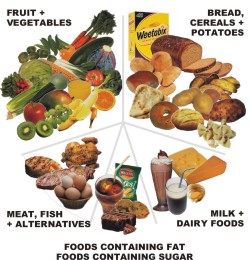Healthy Eating
It is widely recognised that a healthy, balanced diet is essential for preventing disease and illness, managing your weight, living longer and keeping things such as hair, skin and nails in good condition.

Balance of Good Health
The Balance Of Good Health (based on UK government guidelines) is divided into 5 food groups and is a useful reference as to what should make up your diet in order for it to be a healthy, balanced one. Remember, these proportions can be used as a reference for your intake during the course of a meal, over a day, or even throughout a whole week.
The 5 food groups are:
- Bread, cereals and potatoes
- Fruit and vegetables
- Meat, fish and alternatives
- Milk and dairy
- Foods containing fat, foods containing sugar
You should aim to eat around 5-10 portions of starchy foods, such as bread, cereals and potatoes in a day. (This in turn will make sure you are eating enough fibre). Alongside this, 2-3 portions of meat, fish or alternatives, at least 5 portions of fruit and vegetables and you should try to keep to 2 portions of fatty and/or sugary foods.
Good nutrition, a varied diet and keeping fit are the keys to optimum health. Eating correctly is not only a preventative measure, but also promotes maximum health and vitality. Which, in the long run, is something we all wish to achieve!
Eating healthily does not mean that your diet should consist of nothing but salads and steamed vegetables – although both can be extremely enjoyable! A balanced diet is one made up of a bit of everything in the correct proportions. This ensures your body gets enough of what it needs and is in no way deficient. In fact, recommendations on diet are now laid out not just to prevent deficiency, but to actively promote optimal health!
Nutritional requirements vary depending on a person's age, sex and overall level of fitness and with this in mind, the Department Of Health have set guidelines accordingly. Most of us recognise the term RDA (recommended daily allowance). These have been revised and are now set as DRV's (dietary reference values), that are tailored to certain population groups. However, between the ages of 19 and 50 your requirements do not vary a great deal.
For the average adult, it is recommended that around half of our energy should be provided by carbohydrates, 35% from fats and 15% from protein. For most, putting this into practise will mean making sure that you eat a variety of different foods, with emphasis on foods rich in starch & fibre and smaller proportions of fats & sugars. Also, actively trying to eat more fruit & vegetables is always a good idea as they contain many of the wide range of vitamins and minerals the body needs.
It is important to remember that all foods can be included, nothing is forbidden as long as it is eaten in the right proportions!
